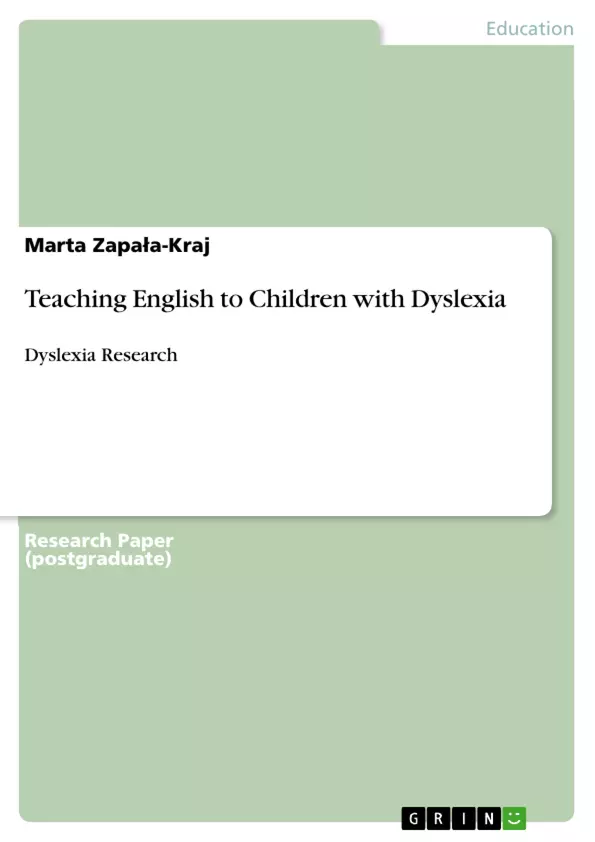Currently, dyslexic children are tested and diagnosed only after they tried and failed to learn how to read. The ideal situation is for a dyslexic to be diagnosed at an early age and learn how to deal with this condition as early as possible. If a dyslexic children fail to get the necessary help, their learning and reading disability will usually result in frustration, loss of self-confidence and, as can be expected, low self-esteem.
Inhaltsverzeichnis (Table of Contents)
- Introduction
- Chapter 1 - Theoretical Background
- 1.1. Terminology and definition of dyslexia
- 1.2. History and Origins of Dyslexia
- The Origins of Dyslexia
- The Evolution of Dyslexia Research
- Modern Approaches towards Dyslexia
- 1.3. Possible Causes of Dyslexia
- 1.3.1. Neurological/Brain Causes
- The Hemispheres
- Phonological Skills
- Visual Aspects
- Motor Control
- 1.3.2. Cognitive/ Learning Causes
- 1.3.3. Educational/Environment Learning Experiences
- 1.3.1. Neurological/Brain Causes
- 1.4. Different Types of Dyslexia
- 1.4.1. Acquired Dyslexia
- Surface Dyslexia
- Deep Dyslexia
- Phonological Dyslexia
- Direct Dyslexia
- 1.4.2. Developmental Dyslexia
- 1.4.1. Acquired Dyslexia
- 1.5. Dyslexia and Language Learning
- 1.5.1. Dyslexics' Major Problems with Studying Words
- Primary Symptoms: Language Weaknesses
- Secondary Symptoms: Class Participation Problems
- 1.5.2. Vocabulary Learning and Dyslexia
- Problems with spelling
- Other problems with studying words
- 1.5.3. Methods of Supporting Students with Dyslexia
- 1.5.1. Dyslexics' Major Problems with Studying Words
- Chapter 2 - Research Methods
- 2.1. Problem Statement
- 2.2. The Case Study Description
- 2.2.1. The 4th Grade Students in Class A
- 2.2.2. The 4th Grade Students in Class B
- 2.2.3. The 4th Grade Students in Public Elementary School
- 2.3. Research Questions
- 2.4. Data Collection Methods and Tools
- 2.4.1. Checklists
- Checklist for the Dyslexic Students
- Checklist for the Dyslexic Students' Parents
- 2.4.1. Checklists
- 2.5. Assessing Reading and Spelling Skills
- 2.5.1. Assessing Word Recognition
- Single-Word Test
- Non-word Spelling Test
- 2.5.1. Assessing Word Recognition
- 2.6. Some Helpful Techniques
- 2.6.1. The Use of RIP Technique
- 2.6.2. Mind Mapping
- Chapter 3 – Data Presentation and Analysis
- 3.1. Introduction
- 3.1.1. Diagnostic criteria
- 3.1.2. Case Study Subjects' Experiences regarding English Courses
- 3.2. The Results
- 3.2.1. Checklist for Dyslexic Students
- 3.2.1.1. Reading Checklist's Results and Discussion
- 3.2.1.2. Spelling Checklist's Results and Discussion
- 3.2.1.3. Writing checklist's results and Discussion
- 3.3. Dyslexics' Parents Checklist
- 3.4. Assessing Word Recognition
- 3.4.1. Single-Word Test
- 3.4.1.1. Materials for Teaching the Vocabulary
- 3.4.1.2. Materials for the Test
- 3.4.1.3. Procedure Design
- 3.4.1.4. Results
- 3.4.2. Non-word Test
- 3.4.2.1. Materials for the Test
- 3.4.2.2. Procedure Design
- 3.4.1. Single-Word Test
- 3.5. Conclusion
- 3.2.1. Checklist for Dyslexic Students
- Chapter 4 - Implications for teaching and learning
- 4.1. General Instruction
- 4.2. Organizational and Study Skills
- 4.3. Language Arts
- 4.4. Test-Taking
Zielsetzung und Themenschwerpunkte (Objectives and Key Themes)
This paper aims to clarify the confusion surrounding dyslexia from the perspective of class teachers and to highlight strategies for dyslexia identification and teaching. The author focuses on providing solutions to ensure that learners with dyslexia have equal access to educational materials.
- Terminology and definition of dyslexia
- History and origins of dyslexia research
- Possible causes of dyslexia
- Different types of dyslexia
- Implications of dyslexia for language learning
Zusammenfassung der Kapitel (Chapter Summaries)
Chapter 1 provides a theoretical background on dyslexia, including its definition, history, possible causes, and different types. It explores the challenges faced by dyslexic individuals in language learning, particularly in acquiring reading and spelling skills.
Chapter 2 outlines the research methods employed in the study, including the case study description and data collection tools. It focuses on assessing reading and spelling skills through various tests and techniques.
Chapter 3 presents the collected data and analyzes the research findings. It includes an in-depth analysis of the case study subjects' strengths and weaknesses in different language areas, with a particular focus on their English language learning abilities.
Chapter 4 offers practical implications for teaching and learning, providing strategies for teachers to effectively support dyslexic learners. It emphasizes the importance of addressing organizational and study skills, language arts, and test-taking strategies.
Schlüsselwörter (Keywords)
The primary focus of this paper is on dyslexia, its definition, history, causes, and impact on language learning. The study uses a case study approach to explore the challenges faced by dyslexic students in acquiring reading and spelling skills. The research examines the effectiveness of various teaching strategies and techniques for supporting dyslexic learners.
- 3.1. Introduction
- Quote paper
- MA Marta Zapała-Kraj (Author), 2009, Teaching English to Children with Dyslexia, Munich, GRIN Verlag, https://www.grin.com/document/275846



